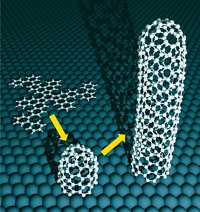Advertisement
Grab your lab coat. Let's get started
Welcome!
Welcome!
Create an account below to get 6 C&EN articles per month, receive newsletters and more - all free.
It seems this is your first time logging in online. Please enter the following information to continue.
As an ACS member you automatically get access to this site. All we need is few more details to create your reading experience.
Not you? Sign in with a different account.
Not you? Sign in with a different account.
ERROR 1
ERROR 1
ERROR 2
ERROR 2
ERROR 2
ERROR 2
ERROR 2
Password and Confirm password must match.
If you have an ACS member number, please enter it here so we can link this account to your membership. (optional)
ERROR 2
ACS values your privacy. By submitting your information, you are gaining access to C&EN and subscribing to our weekly newsletter. We use the information you provide to make your reading experience better, and we will never sell your data to third party members.
Nanomaterials
Twists And Shouts: A Nanotube Story
Nanotechnology’s chiral superstars were overshadowed by hype, but researchers believe they still have potential
by Matt Davenport
June 8, 2015
| A version of this story appeared in
Volume 93, Issue 23

Pulickel M. Ajayan strolls across Rice University’s campus as he talks on his cell phone. It’s hot and humid by almost any standard, but in Houston, it’s just another day. Maybe that’s why Ajayan, founding chair of Rice’s materials science and nanoengineering department, is playing it so cool.
“Go ahead,” he says into the phone, a smile audible in his voice. “Ask me all the hard questions.”
About 15 years ago, the world was supposed to be witnessing the start of a revolution. Scientists said so in grant proposals and white papers. Public relations officers said so in press releases. Reporters said so in magazine articles. Carbon nanotubes were going to change the world.
They could power better televisions. They could replace the silicon in transistors and cutting-edge electronics. They could be used to build an elevator to space. But the nanotube revolution was not televised, silicon is still king of the semiconductors, and space elevators are not currently shuttling passengers to the moon.
So what happened? That’s what Ajayan, who has researched nanotubes for decades, is explaining to C&EN. The short answer, he says, is the same thing that happens with virtually every other exciting new material: hype.
Once researchers realized that nanotubes possessed remarkable properties, people started dreaming up all sorts of applications for them, both realistic and fanciful. But scientists hadn’t yet learned how to create affordable, high-quality carbon nanotubes efficiently. When new nanotube technologies didn’t materialize quickly, people moved on.
Many of the companies that gambled on the promise of nanotubes failed or are still struggling to create a demand for their products. Many scientists left nanotubes to pursue graphene and other materials dubbed “the next big thing,” leaving many nanotube questions unanswered. As the field shrank, so did funding.
Yet, some nanotube companies are profitable. And there are still researchers dedicated to nanotubes who are optimistic about the future. “Nanotubes are exciting,” Ajayan says. “They’re a fascinating material, and they’ve still got potential.”
Ajayan has a unique perspective on nanotubes: He was among the first to call the structures by that name. He had just started working with Sumio Iijima at the Japanese electronics company NEC when Iijima brought nanotubes to the attention of the global scientific community in 1991 (Nature, DOI: 110.1038/354056a0).
Iijima was not the first to discover them, but his work set their future course. He realized that his tubes were like discrete sheets of graphite twisted into hollow cylinders. Iijima and others soon found that these cylinders had incredible electronic and mechanical properties.
Researchers were soon growing semiconducting nanotubes that could beat the size, conductivity, and power consumption of silicon transistor elements. They also showed that nanotubes could be hundreds of times as strong as steel at a fraction of the weight.
“At the time, nanotubes were just another material and a beautiful piece of science,” Ajayan recalls. “I wouldn’t even say there was hype back then. It was excitement.”
But that started to change around the dawn of the new millennium as nanotubes gained fame as a wonder material.
Sporting goods companies started hawking equipment that contained nanotubes before researchers had solidified what benefits the materials provided.
Some in the scientific community anointed carbon nanotubes as silicon’s successor without considering the effort needed to overtake a firmly entrenched, rapidly evolving, and extremely lucrative silicon-based semiconductor industry, Ajayan says.
Still, nanotube manufacturers began investing in the idea that nanotubes would live up to their touted potential. They built facilities with the capacity to produce 2,800 metric tons of carbon nanotubes per year by 2012, says Anthony Vicari, a senior analyst at Lux Research, an independent tech advisory firm. The demand for nanotubes, however, has yet to exceed 20% of the current supply, Vicari estimates.
The manufactured materials themselves are partially responsible for this imbalance. Most commercially available nanotubes are “dirty,” scientists say. Samples contain multiwalled nanotubes: multiple nanotubes of decreasing diameters nested within a larger nanotube. Samples also contain a wide dispersion of diameters and a lot of impurities, such as metal catalyst particles and amorphous carbon.
Cutting-edge electronic applications require high-purity samples made of nearly identical single-walled nanotubes. Single-walled tubes are usually sold by the gram or milligram. Multiwalled tubes, which are easier to produce, are manufactured by the metric ton.
Still, manufacturers were hoping multiwalled tubes could supplant other forms of carbon used as electrode materials in lithium-ion batteries and as fibrous reinforcements in polymer composites.
In 2007, C&EN reported that the market research firm Freedonia Group projected multiwalled tubes would command a market worth $120 million by 2009 and $470 million in 2014 (C&EN, Nov. 12, 2007, page 29). When Lux last compiled actual market values for multiwalled tubes in 2011, global sales were flirting with the $10 million mark and were expected to increase to roughly $55 million by 2020.
With reality failing to match these heightened expectations, there are some signs that industry’s bullish attitudes toward multiwalled tubes are leveling off. Saying the market had become too fragmented, Bayer MaterialScience bowed out of multiwalled tube manufacturing in 2013, lightening the global nanotube capacity by more than 200 metric tons per year.
The Legacy Of Hype
Although Bayer MaterialScience was able to shed this part of its portfolio and move on, many smaller nanotube companies have gone belly-up in the past two decades, researchers say.
The hype surrounding carbon nanotubes during the 1990s and 2000s not only stoked the public’s curiosity, but it also brought out concerns. People began questioning what would happen if these nanoscopic tubes that were supposed to change their lives also entered their bodies. The nanotube community wasn’t fully prepared for these questions.
“Multiwalled carbon nanotubes became the prototypical ‘bad nano,’ ” says James M. Tour, a chemist at Rice and the Smalley Institute for Nanoscale Science & Technology. “Bad” here means toxic.
Large, rigid multiwalled tubes can act a lot like asbestos if inhaled, Tour explains. Small, flexible single-walled tubes, however, pose minimal risk, he states. “Nevertheless, everyone lumps them all together,” Tour says.
“ ‘Carbon nanotubes’ is really a kind of a catchall term for a wide variety of different materials,” says Philip G. Collins, a professor of physics who studies nanotube electronics at the University of California, Irvine. A truly nanoscopic single-walled tube differs greatly from a millimeter-long multiwalled structure, yet both are considered nanotubes.
This imprecise language is especially confounding when coupled with the volume of early publications submitted by researchers trying to carve out a place for themselves in a rapidly growing field, Collins says.
“Everything under the sun was published. Just about anything you can imagine, it’s out there: ‘You can make great peanut butter and jelly sandwiches out of nanotubes,’ ” he says, laughing.
Unfortunately, that also includes important results that appeared to contradict one another. Collins continues: “Nanotubes are toxic. Nanotubes aren’t toxic. Nanotubes are perfect conductors. Oh, no they’re not. Nanotubes are superstrong, except when they break.”
The validity of each claim—and each can be valid—depends on the particular nanotubes, how they were processed, and how they were tested. Researchers now understand this well, and they have brought much needed clarity to the field, says Tour.
But early literature can still present challenges for new nanotube researchers, especially graduate students, who must suss out which claims are legit and under what conditions, Collins says.
Phaedon Avouris also worries about young scientists entering materials research. Avouris, who was Collins’s postdoctoral adviser, performed some of the first experiments characterizing nanotubes at IBM. “It’s very hard to tell young people to ignore the hype,” he says. “We have too many people that follow fashion and patterns rather than their own passions.”
Today, when scientists focus on studying a new material, there is a rush to characterize it, publish papers about its properties in prominent journals, and then move on to a different material, Avouris says. “We’re left with a lot of unfinished work and unproven claims,” he tells C&EN. Researchers develop a fundamental understanding of materials but not how to use them. “Few people are willing to work on the hard problems that will bring applications.”
Avouris adds that many students are drawn to this brand of “novel materials” research with the perceived promise of a high-profile paper, which would look great on a résumé. “You can’t blame them,” he says. “They need to get jobs.”
Another factor that could make nanotube research less attractive to students today is that funding is harder to secure than it was a decade ago, researchers say. Some attribute this to funding agencies following the hype and choosing to finance graphene and other more popular two-dimensional materials rather than nanotubes.
But not everyone agrees with this view. Mihail C. (Mike) Roco is the senior adviser for nanotechnology at the National Science Foundation and a key architect behind the National Nanotechnology Initiative (NNI), which has invested more than $22 billion in nanotech R&D since it launched in 2001 (NSF is one of 20 agencies that contribute to NNI).
“Carbon nanotubes are a component of nanotechnology,” Roco says. “Components are essential in advancing nanoscience, but they’re not the end goal in applications.” NSF and NNI had always intended to move beyond components by 2010 and advance toward the end goal: building nanotech systems that bring new solutions to problems in medicine, industry, and other areas, he says.
Nanotubes 101
Researchers rely on three primary ingredients to grow nanotubes: a carbon source, metal catalyst particles, and heat. The source is often a carbon carrier gas or a graphite slab that scientists atomize with intense heat from an oven, a laser, or lab-generated lightning.
Catalyst particles collect vaporized carbon atoms and serve as assembly points for the carbon to build into hollow cylinders. The diameter of the catalyst particle is related to the diameter of a nanotube: Smaller particles tend to yield smaller tubes.
Nanotubes can have single walls or multiple walls, but each wall consists of a single graphene sheet twisted into a tube. The degree of that twist, or a tube’s chirality, determines whether a nanotube behaves like a metal or a semiconductor. Under most growth conditions, scientists produce about two semiconducting tubes for every conducting tube. Multiwalled tubes are usually electrically conducting.


Nanotubes have certainly helped put researchers on track toward those systems, which Roco says are already appearing as prototypes and will continue to evolve during the next 15 years. “Carbon nanotubes focused attention on understanding matter at the nanoscale, on making new tools, on performance, on how to create groups that could cross disciplines,” Roco explains. He believes that these ideas have benefited the whole of nanotechnology and that they will be the lasting legacy of nanotubes, perhaps more so than any application.
Carbon nanotubes have already secured their place in real applications, though primarily as filler materials to improve the strength of composites or to boost the performance of lithium-ion batteries. Although these technologies aren’t as sexy as next-generation transistors, they are successful enough to sustain companies such as Zyvex Technologies.
Part of the company’s success came from confronting inflated expectations head-on, says Lance Criscuolo, president of Zyvex. “We went out of our way to calibrate our customers’ expectations,” he explains.
The company carefully laid out the benefits of its primarily multiwalled nanotube products compared with more conventional products, such as carbon fiber composites, he says.
Chemistry also played a big role in the company’s success. Carbon nanotubes like to stick to themselves and not a whole lot else, making it difficult to disperse them in a polymer matrix and capitalize on their mechanical properties inside composites. Zyvex functionalized its tubes with conjugated polymers to better integrate the materials with resins.
The National Aeronautics & Space Administration’s path forward with carbon nanotubes also involved directly addressing the surrounding hype, says senior researcher Emilie J. (Mia) Siochi.
The NASA team took a step back around 2008 and started comparing nanotube composites with the materials the agency was already using. “If we’re going to say that nanotubes are a revolutionary material, what are we saying exactly?” Siochi asks. “It means they’ve got to be credible enough to displace state-of-the-art materials.”
The researchers decided that, if they were going to improve existing composites, they needed a concrete target at which to aim. So Siochi and her team asked other materials scientists at NASA, “How much better do we have to be than carbon fiber composites for you guys to care, for nanotubes to make a real difference?”
Advertisement
After having that discussion, the team decided to aim for nanotube-based materials that beat carbon fiber composites’ specific strength—a measure of a material’s strength, taking into account its density. Doubling the specific strength of conventional composites could lighten a spacecraft by thousands of pounds, Siochi says.
Working with their nanotube material supplier, Nanocomp Technologies, the researchers have now created composites with nanotube content in the range of 70–80% by weight. NASA still has a lot of work to do to fully optimize its materials, Siochi says, but recent results are encouraging.
From Filler To Killer
She also believes that her team’s approach to composites could be applied to other areas of nanotube research. “I think we just need to start looking at what are the very specific issues preventing this material from being useful,” she says. “The potential is too great for us not to understand how to take advantage of it.”
Boris I. Yakobson, a theorist who studies materials at Rice, is taking a break from a conference. Sitting with C&EN in an otherwise empty dining room at the Hyatt hotel in Arlington, Va., he sketches a hype curve in his notebook.
The line ramps up to the peak—a region of inflated expectations—and then plummets into the trough of disillusionment. It rebounds with a gentle incline. Yakobson lifts his pen and taps it between the trough and the curve’s endpoint: the slope of enlightenment. “I think we’re here,” he says.
He has several reasons for this claim, and most relate to sample homogeneity. Nanotube growers are getting better and better at producing single-walled tubes, which are needed for high-tech electronic applications, but that’s just one piece of the puzzle.
To understand nanotube homogeneity, Yakobson suggests thinking of what purity means to synthetic organic chemists. Pure samples contain molecules that are exact copies of one another, identical in atomic constituents and structure. “They would never say, ‘Hey, who wants this bucket of mixed hydrocarbons?’ ” he explains.
Nanotubes, however, are typically a mixed bag—or bucket. Every carbon nanotube is made of one atomic species, but the tubes are twisted, or chiral. And the degree of that twist determines a nanotube’s physical and chemical properties.
Even if a growth method produces tubes of identical diameters, it typically yields mixtures of randomly twisted tubes. Two different research groups, however, have recently developed methods to control nanotube chirality.
Yakobson says these results are encouraging, but he’s not convinced either method can be ramped up for use in industrial processes. Commercial synthesis of chirality-controlled nanotubes will likely take many years to develop, he says. In the meantime, researchers have created ways to take the nonhomogeneous nanotube samples and separate them according to chirality.
Mark C. Hersam, who also worked with Avouris at IBM, started working with nanotubes at Northwestern University around 2003 and quickly realized that if he was going to develop innovative technology, he was going to need billions of identical tubes. He thought a separation scheme might help.
Although chirality was at the root of the purity problem, Hersam’s team realized it could also be a solution. Semiconducting tubes are twisted differently than metallic tubes. This different twist influences how nanotubes interact with surfactant molecules in water.
A tube’s chirality determines how surfactant molecules arrange on its surface. The molecules thus decorate differently twisted tubes in varying ways, and these subtle differences in surface chemistry create subtle differences in nanotube buoyancy. Researchers exploit this difference with the help of an ultracentrifuge, which sorts tubes into groups of matching chiralities.
The team was sorting metallic and semiconducting tubes by the end of 2006 and immediately began getting calls from dozens, if not hundreds of researchers asking for samples, Hersam says. “Within a few months, we had raised the money to start a company.” That company, NanoIntegris, was bought by the Canadian single-walled nanotube manufacturer Raymor Industries in 2012. While other research groups are developing alternative methods to sort tubes, Hersam says NanoIntegris has a virtual monopoly over the separation market.
The firm’s purified tube products were recently selling for hundreds of dollars per milligram, but Hersam says high-tech devices may need only $1.00 worth of tubes.

Tube Be Or Not Tube Be
So what might these high-tech applications be? “I’m still obsessed with finding that killer app for nanotubes,” Hersam tells C&EN. “Electronics is where I’m the biggest believer. Printable, wearable, flexible electronics.”
Single-walled nanotubes are becoming increasingly accessible. For instance, the recently launched company OCSiAl committed a metric ton of its product to research projects through a matching grant process. Beyond that, purification methods are evolving, and controlled nanotube synthesis looks to be on the horizon. Sitting on the slope of enlightenment, it’s tempting to look forward and anticipate what might be possible. But nanotube researchers know better.
“It’s really foolish to try to predict with certainty what technology will look like in five years,” says George S. Tulevski, a chemist at IBM trying to create nanotube transistors that outperform silicon electronics. Although this may sound like nanotube hype set to repeat itself, Tulevski is cautiously optimistic.
What’s different now versus 15 years ago is that everyone is fully aware that they need to beat silicon, and the silicon industry isn’t going to sit still. “No one is waiting for nanotubes to catch up,” Tulevski says. “Silicon marches at its own cadence.”
But carbon nanotubes hold an inherent size advantage over silicon. Silicon transistor elements are carved from bulk silicon, and there may be a limit to how small this top-down approach can shrink them, thus halting the hitherto uninterrupted shrinking of transistors and computer technology. But researchers can readily grow nanotubes that are already a fraction of today’s smallest silicon feature.
For IBM, that makes nanotubes worth exploring, but the company isn’t banking on tubes alone. The company is investing $3 billion in advanced computer technologies, including quantum and neuromorphic computing.
There are no guarantees that nanotube transistors can displace silicon technology or that they’ll even need to. Tulevski knows all of this, but he says there’s a lot to learn in the process of trying to build nanotube processors.
“I think now is the most interesting time to work on carbon nanotubes,” he says, noting that it’s unfortunate that the hype died down before the field reached this point, with easier access to pure, single-walled tubes. “But without hype, we’d be nowhere,” he says. “You need that initial burst of money, people, and energy.”
Back at Rice, Ajayan, who was there when nanotubes entered the modern world, admits that he still thinks nanotubes replacing silicon is a far-fetched notion. He agrees with Tulevski that the hype has helped the field. It has also hurt.
But more than hype being good or bad, he says, it’s inevitable. It’s happening now with graphene and other 2-D materials, and it will happen with whatever comes after that.
“It is the nature of things,” Ajayan tells C&EN before hanging up. Perhaps understanding that notion will be the nanotube revolution.





Join the conversation
Contact the reporter
Submit a Letter to the Editor for publication
Engage with us on Twitter